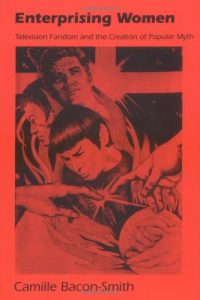

 Add To Collection
Add To CollectionFormat: Book: Paperback
Language: English
Published by: University of Pennsylvania Press
ISBN-10: 0812213793
ISBN-13: 978-0812213799
Length: 352
Published On: 1991-12-01
Buy on Amazon.com
Buy On BarnsAndNoble.com
Buy On Bookshop.com
Buy On Books-A-Million.com
Wikipedia.org
Find on E-Bay
Enterprising Women is a study of the worldwide community of fans of Star Trek and other genre television series who create and distribute fiction and art based on their favorite series. This community includes people from all walks of life — housewives, librarians, secretaries, and professors of medieval literature. Ninety percent of its members are women. They take settings, plots, and characters from Star Trek, Blake’s 7, Miami Vice, and other science fiction and action-adventure series and modify the settings, rework the plots, create new characters, and invent new interactions among old characters.
The fiction and art that result from this re-creation are published in magazines called “fanzines” and sold through an intricate network of conventions, word of mouth, cross-advertising, and catalogs. All of the community’s publications are underground and are not sold for profit. No one in the community makes money from her writing, drawing, editing, or distributing of fan art and fiction.
Camille Bacon-Smith asks the question: Why do members of this community — who have jobs and families to take care of — spend time, energy, and money creating and sharing pictures and stories about worlds they have seen only on television? Using a theoretical framework drawn from ethnolinguistics, mass communications studies, literary theory, the sociology of play, and feminist studies, and calling upon knowledge gained from years of participant observation in the fan community, the author shows us how members of the community use their fiction and art to help them cope with real-life problems and to find support and comfort in community. While the results are often surprising, sometimes, disconcerting, they are always a tribute to the struggle of the artist in all of us to be seen, to be heard, and to matter in our community.
Enterprising Women is valuable not only for what it reveals about the fan community but, equally important, for what it tells us about how audiences receive and use mass media entertainment. It will be a unique resource for students and scholars of literature, American studies, women’s studies, and popular culture.
Related Books
No related books found.







